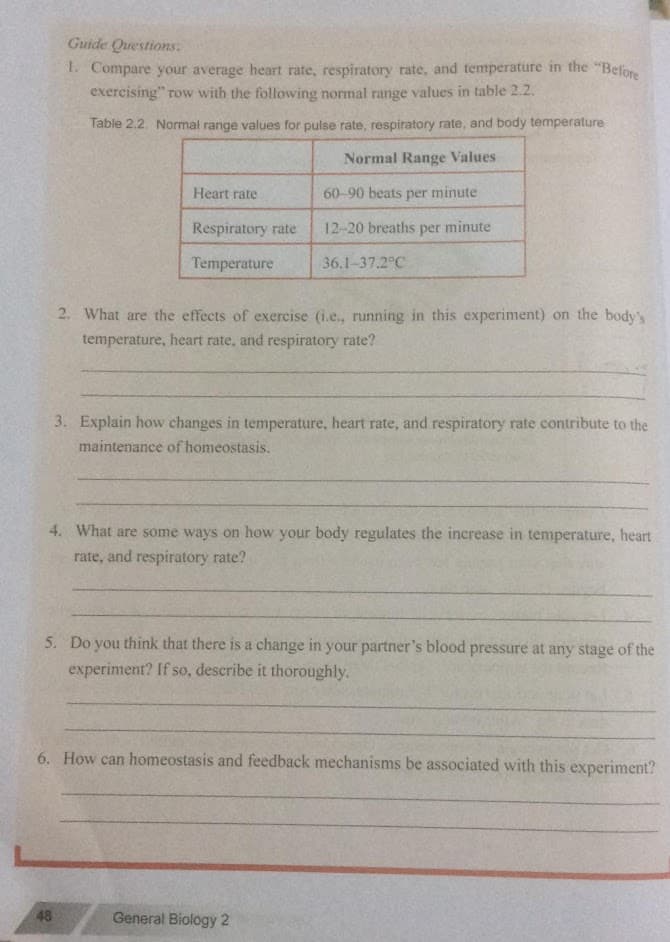1. Compare your average heart rate, respiratory rate, and temperature in the "Before exercising" row with the following normal range values in table 2.2. Table 2.2. Normal range values for pulse rate, respiratory rate, and body temperature Normal Range Values Heart rate 60-90 beats per minute Respiratory rate 12-20 breaths per minute Temperature 36.1-37.2°C What are the effects of exercise (i.e., running in this experiment) on the body's temperature, heart rate, and respiratory rate? Explain how changes in temperature, heart rate, and respiratory rate contribute to the maintenance of homeostasis.
1. Compare your average heart rate, respiratory rate, and temperature in the "Before exercising" row with the following normal range values in table 2.2. Table 2.2. Normal range values for pulse rate, respiratory rate, and body temperature Normal Range Values Heart rate 60-90 beats per minute Respiratory rate 12-20 breaths per minute Temperature 36.1-37.2°C What are the effects of exercise (i.e., running in this experiment) on the body's temperature, heart rate, and respiratory rate? Explain how changes in temperature, heart rate, and respiratory rate contribute to the maintenance of homeostasis.
Surgical Tech For Surgical Tech Pos Care
5th Edition
ISBN:9781337648868
Author:Association
Publisher:Association
Chapter7: Preventing Perioperative Disease Transmission
Section: Chapter Questions
Problem 7.2.5CS
Related questions
Question

Transcribed Image Text:Guide Questions:
1. Compare your average heart rate, respiratory rate, and temperature in the "Befor
exercising" row with the following normal range values in table 2.2.
Table 2.2. Normal range values for pulse rate, respiratory rate, and body temperature
Normal Range Values
Heart rate
60-90 beats per minute
Respiratory rate
12-20 breaths per minute
Temperature
36.1-37.2°C
2. What are the effects of exercise (i.e., running in this experiment) on the body's
temperature, heart rate, and respiratory rate?
3. Explain how changes in temperature, heart rate, and respiratory rate contribute to the
maintenance of homeostasis.
4. What are some ways on how your body regulates the increase in temperature, heart
rate, and respiratory rate?
5. Do you think that there is a change in your partner's blood pressure at any stage of the
experiment? If so, describe it thoroughly.
6. How can homeostasis and feedback mechanisms be associated with this experiment?
48
General Biology 2
Expert Solution
This question has been solved!
Explore an expertly crafted, step-by-step solution for a thorough understanding of key concepts.
This is a popular solution!
Trending now
This is a popular solution!
Step by step
Solved in 2 steps

Knowledge Booster
Learn more about
Need a deep-dive on the concept behind this application? Look no further. Learn more about this topic, biology and related others by exploring similar questions and additional content below.Recommended textbooks for you

Surgical Tech For Surgical Tech Pos Care
Health & Nutrition
ISBN:
9781337648868
Author:
Association
Publisher:
Cengage


Comprehensive Medical Assisting: Administrative a…
Nursing
ISBN:
9781305964792
Author:
Wilburta Q. Lindh, Carol D. Tamparo, Barbara M. Dahl, Julie Morris, Cindy Correa
Publisher:
Cengage Learning

Surgical Tech For Surgical Tech Pos Care
Health & Nutrition
ISBN:
9781337648868
Author:
Association
Publisher:
Cengage


Comprehensive Medical Assisting: Administrative a…
Nursing
ISBN:
9781305964792
Author:
Wilburta Q. Lindh, Carol D. Tamparo, Barbara M. Dahl, Julie Morris, Cindy Correa
Publisher:
Cengage Learning
